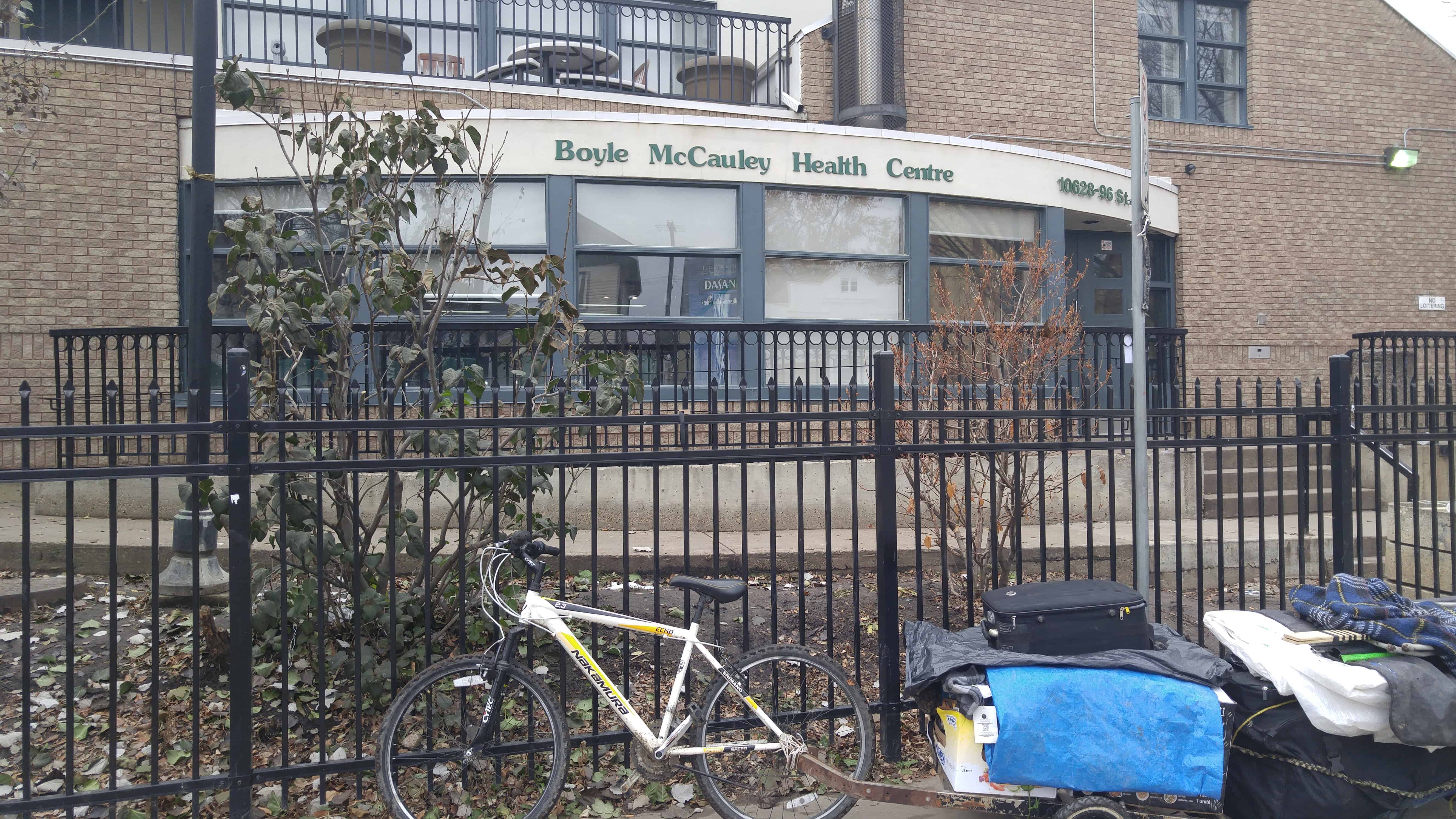Seeking a safe place for supervised injections
In the third-floor office of the Hull Block, a red brick Edwardian building on the edge of Chinatown, Georgina Fiddler keeps a photo album most people would find unsettling.
The images capture scenes she sees during walks around the southwest corner of McCauley: discarded syringes, empty vials, and people curled up on the concrete.
“I would have called 911 on that one because he wasn’t moving,” she said, lingering on one. “A needle with blood in it, people sleeping—this is every single day, and these are only a few of the pictures I have.”
Fiddler, 63, has worked at the Hull Block for 10 years, and has lived there the last six. Three years ago, she started posting a digital version of the album on Twitter, tagging neighbouring agencies in protest, like the Boyle McCauley Health Centre (BMHC), a clinic down the street hosting a needle exchange service for IV drug users.
“They don’t even hide anymore,” Fiddler said. “They just come out onto the steps and shoot their drugs. But if they put a safe injection site here in Chinatown, this will become East Hastings.”
The infamous drag in Vancouver’s Downtown Eastside is well known for drug and criminal activity. But since 2003, East Hastings has drawn attention as the home of Insite, the first legal supervised injection facility in North America.
Under a federal exemption from the Controlled Drugs and Substances Act, Insite provides clean equipment, space, and medical supervision to help users who bring their own drugs avoid some of the deadly hazards they would otherwise face, such as infection, disease, and overdose.
Since opening, the facility has had nearly 3.5 million visits and 4,922 non-fatal overdose interventions.
Five years ago, a group of researchers and healthcare professionals formed a committee to gather support for similar services in Edmonton. In October, the provincial government announced a $230,000 grant to the group, known as Access to Medically Supervised Injection Services Edmonton (AMSISE), for public consultation on plans to integrate safe injection services into a few, yet-to-be-named, inner-city agencies.
The goal of the service is harm reduction, said executive director of BMHC and AMSISE member Cecilia Blasetti. Harm reduction is an intervention strategy that tailors addiction treatment to a user’s needs, starting with the damaging effects of drug abuse and minimizing them where possible.
“So you don’t alienate [users] by judging and asking the impossible,” Blasetti explained, “you say, ‘What change can you manage?’ and then, ‘What can we support you to do, for you to be safe?’”
Unlike traditional intervention, which prescribes abstinence as treatment, harm reduction manages addiction more like an illness, alongside the symptoms, and less like a moral failure.
“You may be preventing HIV, you may be preventing hepatitis C, you may be preventing overdose, all those sorts of things,” Blasetti added. “It has a very big impact on cost to the healthcare system, but it also has a big impact in terms of the health of the person.”
According to Alberta Health and Wellness, medical services for Albertans with hepatitis C between 2004 and 2009 cost $22.5 million, or an average of $3,500 per person, per year.

As a member of Streetworks, an interagency harm reduction network, the BMHC is one of several inner city sites exchanging needles and providing clean equipment to mitigate the risks of injecting on the street.
In April, Global News reported that from April 2015 to March 2016, Streetworks dispensed 1.75 million needles, a 22 per cent increase from the year before. Six months later, in October, CBC News reported that 1.13 million more had been handed out since then.
Streetworks’ voluntary exchange program leaves Fiddler unconvinced that harm reduction serves the long-term interests of users or her community.
“So you shoot up in there, but you’re still coming out onto the street. The pushers are still there selling their drugs in my neighbourhood.”
But infection and overdose aren’t the only risks facing street users.
Leah, 47, who asked that her last name be withheld, used to inject on inner-city streets and remembers when clean equipment wasn’t as accessible as it is now.
A survivor of childhood trauma and then a motorcycle accident in the early ’90s, Leah gradually moved from prescription painkillers to a 12-year, on-and-off IV drug habit. Between 2000 and 2012, she shot morphine, dilaudid, and cocaine to numb the physical and emotional pain of her past while keeping pace with her climbing tolerance.
In December, she celebrated four years of sobriety. But the scars of her past are still visible on her hand, swollen and pink from using dull needles when new ones were hard to find.
“You couldn’t even go to the pharmacy,” she said. “They wouldn’t give them to you, so you just reuse. And people would be filing them down.” She continued, “It was still so hidden at that point in time. We were in back alleys, people were drawing water out of puddles, making cotton out of [cigarette filters]. Whatever you could get available.”
Sometimes that meant sharing equipment. Other times it meant sharing space, like a shelter or a place to get high. Miraculously, Leah managed to avoid contracting HIV and hepatitis C, but she recalls one time when the need for space put her into a terribly compromising position.
“I was downtown in the inner city in Edmonton and I wanted to get high,” she said. “And I had the drugs but I had no place to use. I didn’t have the needles, so I went with a fellow and another girl to where they were staying—his house—and I was raped.”
With access to a clean safe place to inject, she said, “I wouldn’t have had to make that connection.”
Header image: Discarded needles, like this one found at 96 St. and 106A Ave., are not an uncommon sight around the Hull Block. | Hamdi Issawi







